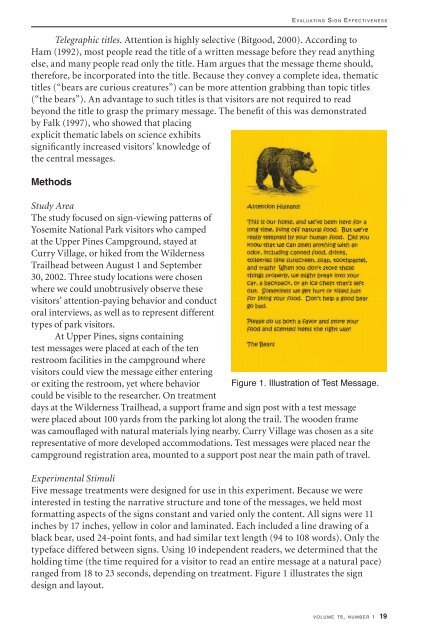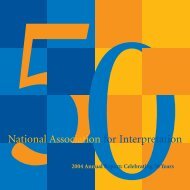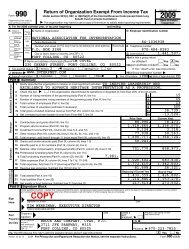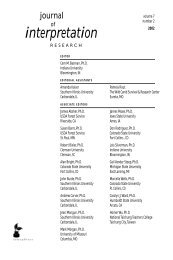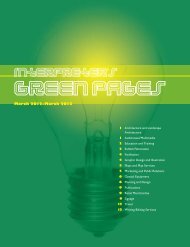interpretation
Volume 15, Number 1 - National Association for Interpretation
Volume 15, Number 1 - National Association for Interpretation
Create successful ePaper yourself
Turn your PDF publications into a flip-book with our unique Google optimized e-Paper software.
Telegraphic titles. Attention is highly selective (Bitgood, 2000). According to<br />
Ham (1992), most people read the title of a written message before they read anything<br />
else, and many people read only the title. Ham argues that the message theme should,<br />
therefore, be incorporated into the title. Because they convey a complete idea, thematic<br />
titles (“bears are curious creatures”) can be more attention grabbing than topic titles<br />
(“the bears”). An advantage to such titles is that visitors are not required to read<br />
beyond the title to grasp the primary message. The benefit of this was demonstrated<br />
by Falk (1997), who showed that placing<br />
explicit thematic labels on science exhibits<br />
significantly increased visitors’ knowledge of<br />
the central messages.<br />
Methods<br />
Study Area<br />
The study focused on sign-viewing patterns of<br />
Yosemite National Park visitors who camped<br />
at the Upper Pines Campground, stayed at<br />
Curry Village, or hiked from the Wilderness<br />
Trailhead between August 1 and September<br />
30, 2002. Three study locations were chosen<br />
where we could unobtrusively observe these<br />
visitors’ attention-paying behavior and conduct<br />
oral interviews, as well as to represent different<br />
types of park visitors.<br />
At Upper Pines, signs containing<br />
test messages were placed at each of the ten<br />
restroom facilities in the campground where<br />
visitors could view the message either entering<br />
or exiting the restroom, yet where behavior Figure 1. Illustration of Test Message.<br />
could be visible to the researcher. On treatment<br />
days at the Wilderness Trailhead, a support frame and sign post with a test message<br />
were placed about 100 yards from the parking lot along the trail. The wooden frame<br />
was camouflaged with natural materials lying nearby. Curry Village was chosen as a site<br />
representative of more developed accommodations. Test messages were placed near the<br />
campground registration area, mounted to a support post near the main path of travel.<br />
Experimental Stimuli<br />
Five message treatments were designed for use in this experiment. Because we were<br />
interested in testing the narrative structure and tone of the messages, we held most<br />
formatting aspects of the signs constant and varied only the content. All signs were 11<br />
inches by 17 inches, yellow in color and laminated. Each included a line drawing of a<br />
black bear, used 24-point fonts, and had similar text length (94 to 108 words). Only the<br />
typeface differed between signs. Using 10 independent readers, we determined that the<br />
holding time (the time required for a visitor to read an entire message at a natural pace)<br />
ranged from 18 to 23 seconds, depending on treatment. Figure 1 illustrates the sign<br />
design and layout.<br />
v o l u m e 15, n u m b e r 1 19


